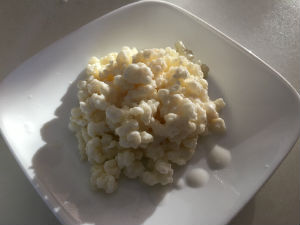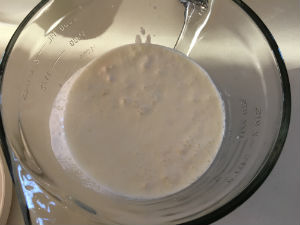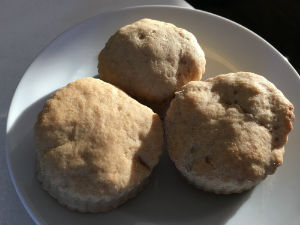 We’re into fermenting. Right now, we do kombucha, water kefir, and milk kefir (and lacto-fermented sauerkraut). There’s also a really chunky Jun scoby languishing up in the cupboard, but that’s a story for another day.
We’re into fermenting. Right now, we do kombucha, water kefir, and milk kefir (and lacto-fermented sauerkraut). There’s also a really chunky Jun scoby languishing up in the cupboard, but that’s a story for another day.
Basically, you take milk kefir grains (which look like large cottage cheese curds), put them in milk, stir them, and over time, they turn the milk into a delightful beverage that’s like slightly runny yogurt. It’s also full of probiotics. Some people like to add fruit or blend it into a smoothie. If you use heavy cream as your base, you get a thick kefir that’s like a cross between whipped cream and sour cream. It works well on tacos or atop an egg custard. Strained through cheesecloth, milk kefir makes a very nice farmer’s cheese.
 Our milk kefir has been “trained” to do its thing in the refrigerator, with breaks of a couple of days of room-temperature fermenting to keep the grains active. This helps ensure a manageable amount of product. The slower ferment at cooler temperatures seems to create a smoother, less-tangy kefir, too.
Our milk kefir has been “trained” to do its thing in the refrigerator, with breaks of a couple of days of room-temperature fermenting to keep the grains active. This helps ensure a manageable amount of product. The slower ferment at cooler temperatures seems to create a smoother, less-tangy kefir, too.
Finished kefir keeps in the fridge for a long time, and becomes more effervescent with time. Imagine that – it’s like fizzy yogurt! Our dogs also love milk kefir, and snap up any “grains” with great gusto. The grains themselves actually taste like tart gummy candy. We try not to eat them so they can propagate, but every once in a while, a tiny one will make into a glass of kefir.
 Bread, biscuits, and other baked goods can be made with milk kefir. We made biscuits today, and they turned out moist inside and crunchy on the outside. Pancakes and waffles made with milk kefir also turn out great – it works like buttermilk in recipes.
Bread, biscuits, and other baked goods can be made with milk kefir. We made biscuits today, and they turned out moist inside and crunchy on the outside. Pancakes and waffles made with milk kefir also turn out great – it works like buttermilk in recipes.
If you’re looking for an easy, tasty way to add probiotics to your diet, try making milk kefir. It’s fun fishing the grains out of the kefir, too!
More info on milk kefir here: https://www.yemoos.com/pages/milk-kefir-overview.
